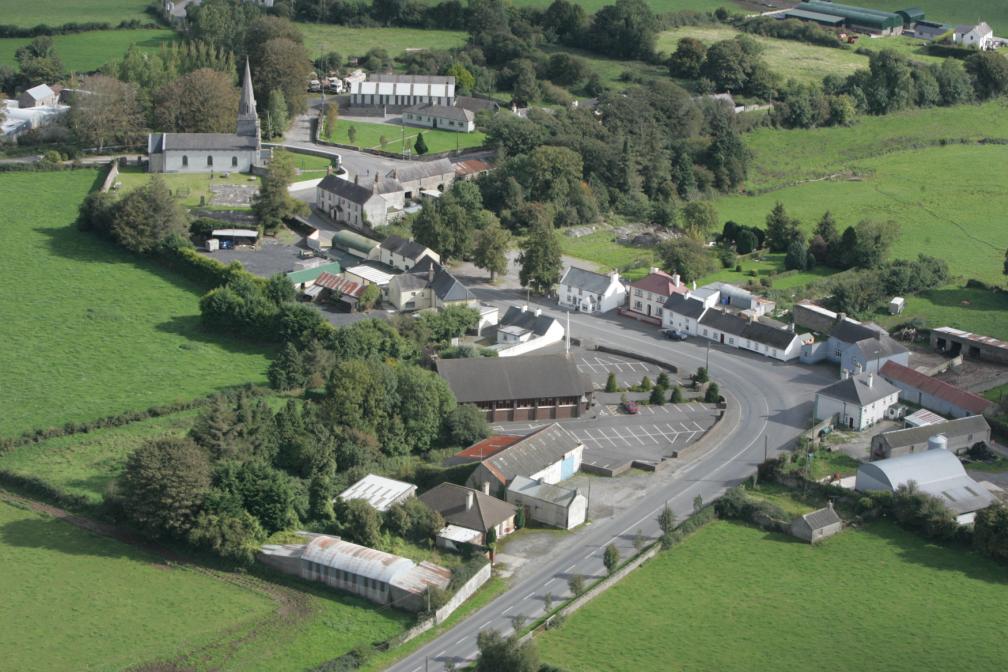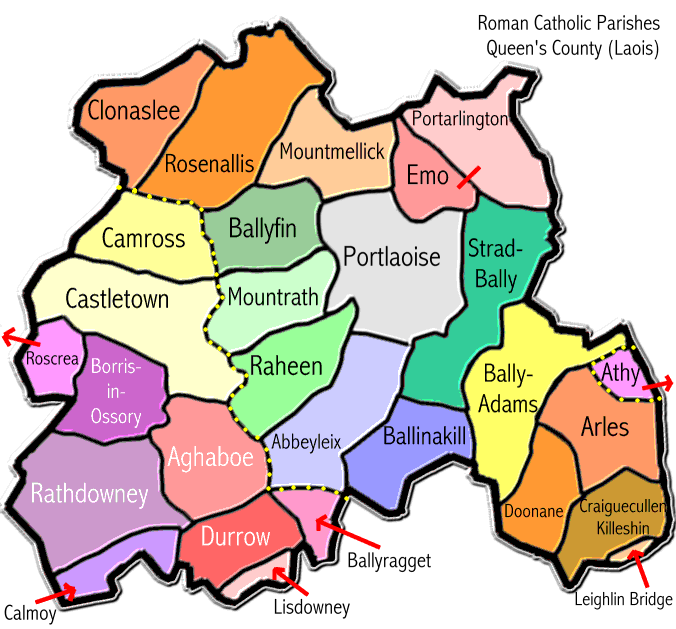About Rosenallis
 Rosenallis
village is situated on the northeast end of Capard Ridge in the
Slieve Bloom Mountains in County Laois in what William Bulfin in his
book “Rambles in Eirinn”, called “The Smiling Midlands”. This
village is not on the normal tourist trail, and therefore, little
discovered; but several viewing points in the vicinity provide a
wonderful vista of the lush green central plain of Ireland. It is
said that you can see six counties from the “Stoney Man” on the
Ridge of Capard – the finest viewing point in the centre of Ireland
– and which is also on the “Slieve Bloom Way” lomg distance walking
trail.
Rosenallis
village is situated on the northeast end of Capard Ridge in the
Slieve Bloom Mountains in County Laois in what William Bulfin in his
book “Rambles in Eirinn”, called “The Smiling Midlands”. This
village is not on the normal tourist trail, and therefore, little
discovered; but several viewing points in the vicinity provide a
wonderful vista of the lush green central plain of Ireland. It is
said that you can see six counties from the “Stoney Man” on the
Ridge of Capard – the finest viewing point in the centre of Ireland
– and which is also on the “Slieve Bloom Way” lomg distance walking
trail.
If it’s peace and quiet you want, then you will find it here – up
the mountain road, up over the woods and meadows and tillage fields,
up into the freer, purer air, up where you will meet the busy bee
flying homeward laden with honey sucked from the heather and the
blazing yellow bloom of the golden furze.
Visit the Barrow valley nearby (three kilometres) and walk to it’s
beautiful waterfall – the Clamphole Falls. Visit the Cathole Falls
on the Owenass river (five kilometres) and picnic on the banks of
it’s dark pool, or enjoy a swim in the cool mountain water.
If you are a “walker”, there are walks of varying distances from
three kilometres to thirty kilometres to do, depending on whether
you have one day or two days or more to spend in the area. There are
nearby B&Bs in which to stay and the Irish Tourist Office in
Portlaoise will assist you with accommodation.
The name “Rosenallis” according to early Irish writers, Comes from
the Irish “Ros-Fionn-Glais” (The wood of the clear stream). Saint
Brigid founded a church and a convent here and there was also a
round tower. The ruins of the church and tower were still standing
in the year 1819. They were later removed. A well in the village is
called “Saint Brigid’s Well”. William Bulfin urges us to “Quench our
thirst at the village well. It is a spring more refreshing than the
deepest draught of the rarest wine in Europe”
After the Williamite wars against James II (1689-1692) – General
Ginkel is said to have quartered his soldiers in Rosenallis village
and he himself stayed in Capard House (three kilometres distant)
owned by Robert Pigott. A copy of the treaty of Limerick was kept in
Capard House up to the 1960’s when it was handed over to the
National Museum by the then owner Mr. Charles de Jenner who died in
1973 and is buried in the estate grounds. The present owners of
Capard Estate are Mr. John Farrington and Mr. Tom Dobbyn.
Capard House, Summergrove House and Derry House are the three big
houses in Rosenallis Parish, each occupied and each with a very
interesting history.
The present village of Rosenallis is of Quaker Origin, and dates
back to the coming of the Society of Friends to Ireland under the
direction of their founder William Edmundson who came to Ireland
from Scotland and settled first in Virginia in Co. Cavan and then
settled in Mountmellick and Rosenallis in 1659. William Edmundson
died in 1712 and is buried in the Quaker burial ground in
Rosenallis, the oldest in Ireland. The plaque near his grave reads –
"Near this spot is buried William Edmundson, the first member of the
Society of Friends who settled in Ireland. Died 31st of 6th Month
1712 (old style). Aged nearly 85 years." The Quaker burial ground on
the outskirts of village, remains a true monument to these early
settlers.
Two houses in the village have plaques over their doors dated 1730
and 1733 – the latter house was the last two storey thatched house
in the locality. In 1831, the village had 19 families and population
of 101. By 1841 the number of houses had risen to 254. In the Great
Famine of 1845 to 1847 the Quakers gave great assistance to the
local starving people by running a “soup kitchen” in the house dated
1733, which is now known as “The Rambler’s Rest”, a local public
house and grocery. Indeed, the large iron cauldron used for making
the stew or soup with it’s chains for hauling it up over the fire
and the ladles for ladling out the soup are still in the possession
of the proprietors. The other public
house in the village “Shelley’s” which is now sadly closed, was a refuge and a “safe house” for
priests “on-the-run” during the Penal Days in Ireland. The late Mrs. Shelley
had in her possession certain items belonging to that time so,
if you are visiting Rosenallis from Ireland or abroad, you will
receive a very warm welcome from the people of the locality and you
will not regret having come here.
The Roman Catholic Parish of Rosenallis is one of the larger in area within the diocese of Kildare and Leighin. Below is a map which shows Rosenallis along with the other parishes in County Laois.
